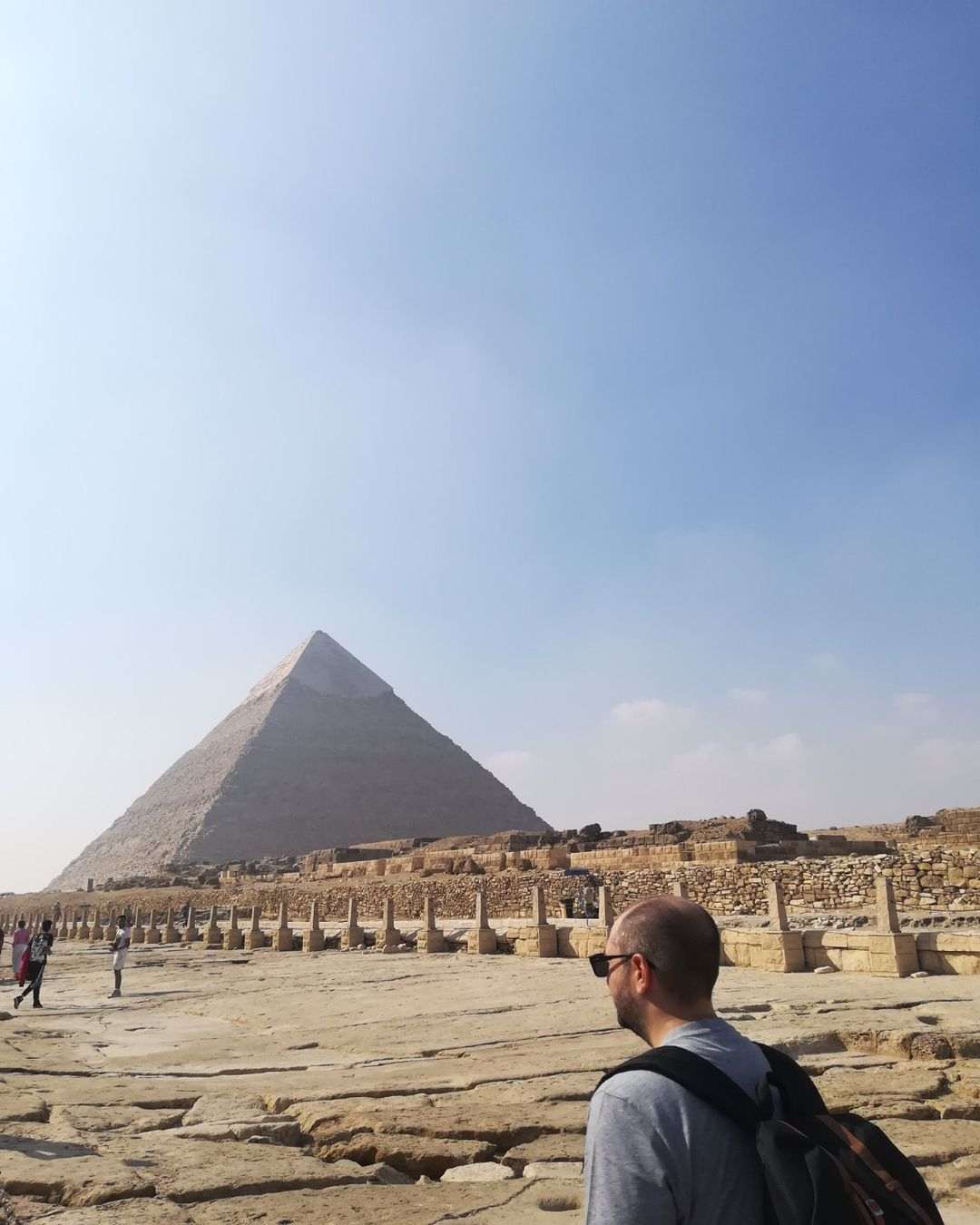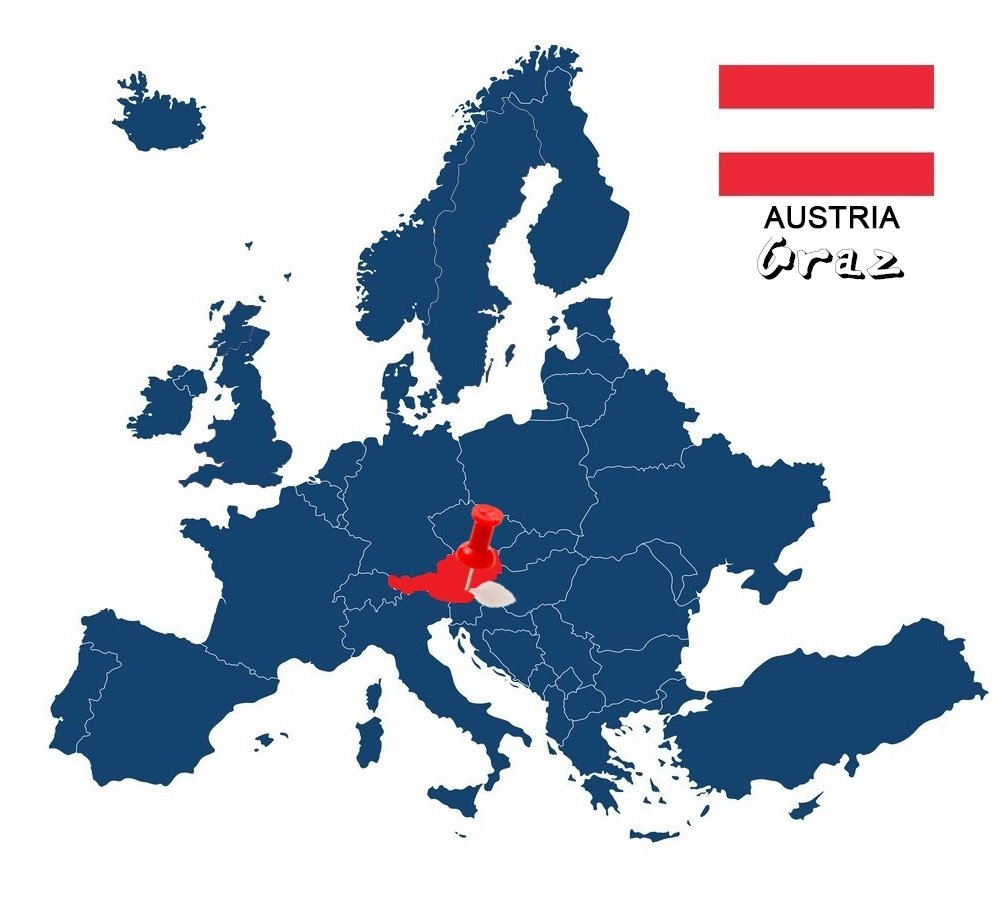
When you think about Austria, Graz may not even come to your mind, but this fairytale city is an ideal destination for all seasons of the year. The award-winning modern buildings coexist harmoniously with the top attractions of Gothic, Renaissance and Baroque architecture, offering a unique experience to every visitor.
A few words about the city
Graz is the second largest city in Austria and the capital of the federal state of Styria. It has 287,723 inhabitants, while maintaining a long tradition as a student city, with six universities and over 40,000 students from Austria and abroad. Graz's name comes from the Slovenian word Gradec, which means small castle. The Old Town is also one of the best preserved city centres in central Europe and was added to UNESCO's World Heritage List in 1999. So I have chosen for you, what I consider to be worthy of attention for someone who is visiting the city for the first time.
Schlossberg
The verdant hill of the Castle (Schlossberg) is the place where the fortress of Graz is located and the place from where one can better see the city from above. The fortification of the hill dates back to at least the 10th century, while the Fortress dates back to the 16th century, designed by Italian architects. This castle is even to be proud that it was never conquered, but was largely destroyed by Napoleon's forces in 1809. Admission costs 2.40e.
There you will also find the landmark of the city, which is none other than the Clock Tower (Uhrturm). It dates back to the 13th century and is 28 meters tall. The oxymoron with this clock is its indicators have opposite roles than regular clocks, since the large indicator shows the hour and the small one the minutes. This is because the original watch only had one indicator, as was customary then, and so when the other one was added later, it was decided to make it smaller to make the time look better! To climb the hill, you can use the cable car (2.5e), the elevator (1.70e) or if you are brave enough to climb the 260 steps.
Grazer Dom
The Cathedral of Graz (Grazer Dom), which is dedicated to St. Giles, is one of the most important buildings of the city and the entire state of Styria. It is the seat of the bishop of the Diocese of Steiermark and was built between 1438 and 1462 by Friederick III in Gothic architecture. Although externally it does not radiate grandeur, its interior is magnificent, as it harmoniously combines Gothic architecture with baroque furnishings. It features dozens of frescoes, the most important of them the so-called "Gottesplagenbild," which refers to a year of horrors suffered by Graz in 1480. The city was struck by three plagues, considered as a punishment of God-grasshoppers, war and Black Death. Admission is free.
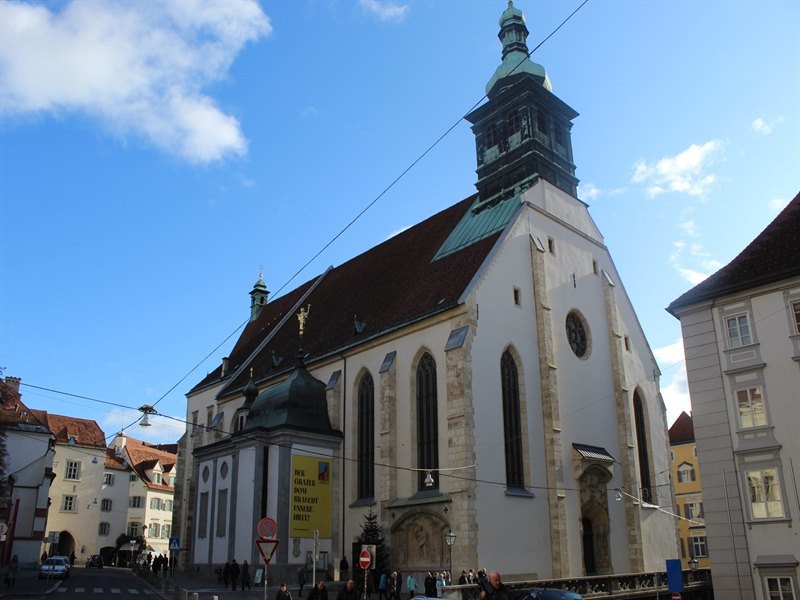
Right next door is the Mausoleum of Emperor Ferdinand II, which consists of two separate buildings, the Church of St. Catherine (Katharinenkirche) and the adjacent chapel for Emperor Ferdinand and his family. It is a beautiful building complex of the 17th century, whose turquoise domes make it stand out from any other building in the city, while strongly reminiscent of the Cathedral of Florence. This complex, which began in 1614 and was completed in 1714 after decades of construction interruptions, is one of the most important architectural monuments of Austria, in the transition period from the Renaissance to the Baroque. And here the entrance is free.
Murinsel
The island of Moor (Murinsel) is an artificial floating island in the middle of the river of the same name, which connects its two banks. This landmark of the city was built only in 2003, as part of the celebration of the fact that Graz became the European capital of culture that year. Designed by New York artist Vito Acconci, it is a wonderful place to drink coffee or enjoy a cocktail, while in the evening it is illuminated in blue, which makes it even more impressive.
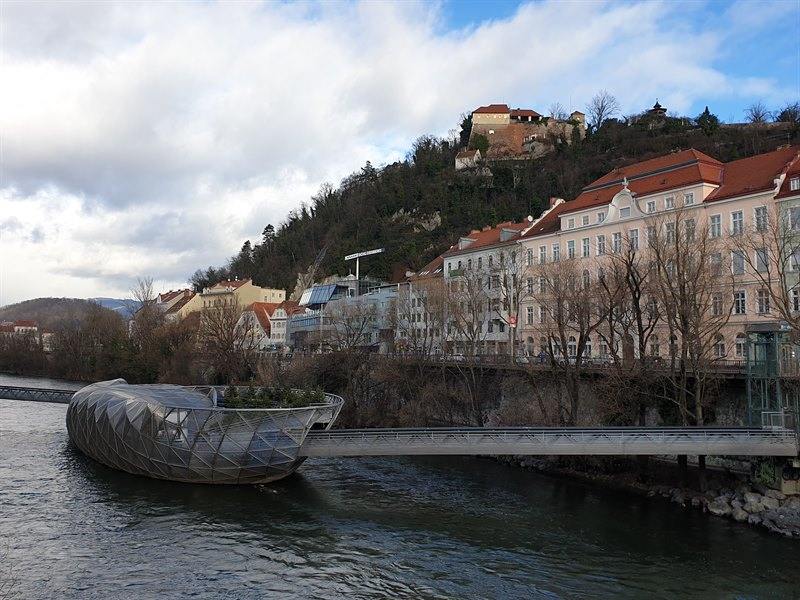
Grazer Rathaus
Without any doubt, the heart of Graz is the Hauptplatz, dominated by the Town Hall (Grazer Rathaus). It is always full of life, locals, tourists and street vendors, offering juices and sausages. From there you can even reach all the sights of the city in just one stop!
The town hall itself has a brilliant past and went through many stages until it took its present form. Graz's first town hall on this site was built in 1550, but about three centuries later it was demolished (1803) and replaced by a new building of classicist type. In the following decades and with the contribution of the local community, the building expanded, taking its present aspect. In the 1960s, a modification to the facade of the building was discussed, which would simplify it. The question was asked in a referendum in July 1966 and the people decided by a large majority (83%) to maintain the present facade.
Oper Graz
The Opera of Graz is one of the most beautiful buildings in the city and highlights its cultural sensitivity. In Graz, the opera has been in the everyday life of the inhabitants since the 17th century, but this building, designed by Ferdinand Fellner and Herman Helmer in neo-baroque style, was inaugurated only in 1899. A bombing raid in World War II caused the demolition of the original door, which was later renovated to a more "minimal" pace simplifying the entire facade. It can accommodate 1200 seated spectators, has awesome acoustics and is decorated with Baroque paintings. If you find yourself in the city, do not hesitate to look for tickets for a show.
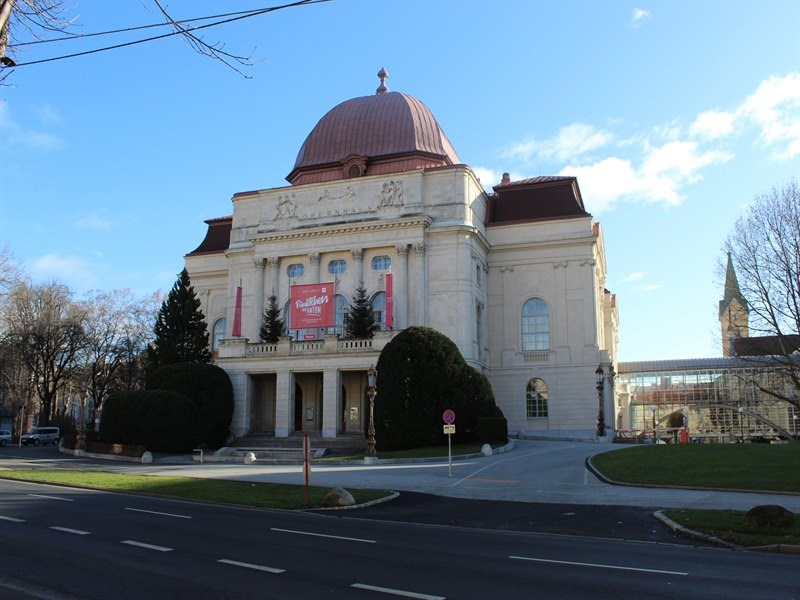
Museums
The Armory of Graz (Landeszeughaus) is one of the most important sights of the city. It was built between 1642-1647 and was once the central weapons depot in Styria. It has over 32,000 exhibits and is the largest arsenal in the world, which has been largely preserved in its original state! It has four floors, and on them you can admire shields, helmets, Javelins, swords, axes, cannons and many other weapons from the time of the Middle Ages. It is part of Universal Museum Joanneum and annually attracts thousands of tourists and lovers of historical weapons from all over the world. Admission costs 9.5e.
The building of the Art Museum (Kunsthaus) is something that you certainly do not see every day. Designed by world-renowned architects Peter Cook and Colin Fournier, it looks like a huge blue whale or as locals are wont to say a friendly alien. It was built in 2003 as part of the city's preparation as European capital of Culture and has since become one of Graz's most characteristic landmarks. Its exhibition program specializes in contemporary art since the 1960s and features works by both Austrian and international artists. Admission costs 9.5e.
Finally, it is worth visiting the most important Gallery of Graz, the New Gallery (Neue Galerie). There the visitor will have the opportunity to admire a wide range of works of art from Bidermeier, Art Nouveau, and Expressionism to classical modernism and positions in Austrian and international painting after 1945. Paintings, statues, manuscripts, photos, videos and interactive exhibits will certainly raise your attention. And here the entrance costs 9.5e.
Schloss Eggenberg
Last I left the Egenberg Palace (Schloss Eggenberg). This baroque masterpiece is located in the western part of the city and ranks among Austria's most valuable cultural treasures. It was built in the middle of the 17th century, but many of its pieces date back much later, while it was the den of the only dynasty of Styria, the House of Eggenberg. On the ground floor, the palace hosts, a particularly interesting monetary collection (Coin Cabinet), while on the first floor we meet the Old Gallery (Alte Galerie). This includes a wide variety of paintings, sculptures and other works of art from the medieval era to the beginning of the modern period, covering five centuries of European art history. Outside you will be confronted with its impressive gardens and the new Archaeological Museum (Archäologiemuseum). Entrance to the palace costs 15e, while if you just want to wander through the gardens you will have to pay just 2e.
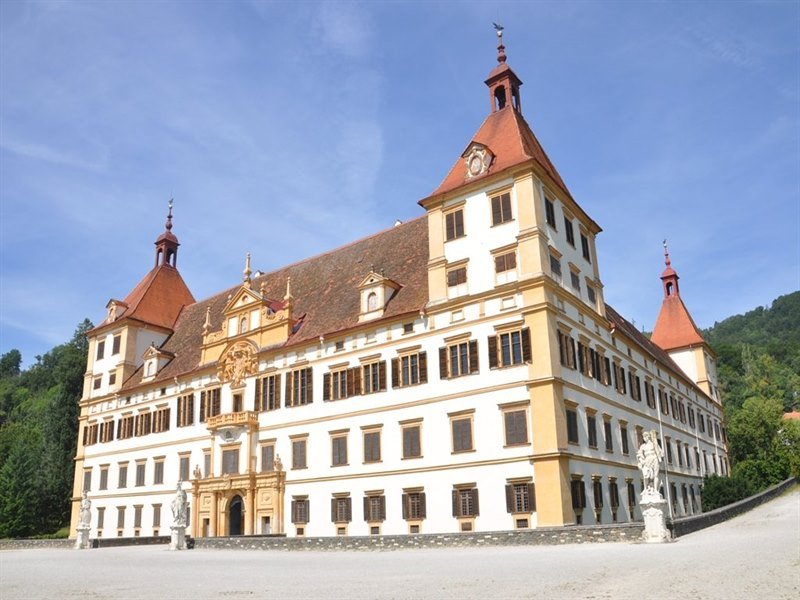
How to go
Unfortunately, there are no direct flights from Thessaloniki to Graz, so you will need to make at least a stopover to get to the city. The most economical option comes from Austrian Airlines with a stopover in Vienna, where with proper planning one can find tickets starting from 294€ round trip.
Where to stay
Graz is not one of Austria's most popular tourist destinations, such as Vienna or Salzburg, so prices are relatively cheaper. Since most of the attractions are concentrated around the historic city center, it would be wise to find something around. So my suggestion is Hotel Mariahilf, a 3-star hotel, fully equipped, right next to Kunsthaus.
How to move
Graz's main tourist interest, as I mentioned above, focuses on its historic centre, which is easily reached on foot. However, if you need public transport, Graz has a very modern system. It has trams and buses, which cover the whole city and many of them, operate twenty-four hours a day! Depending on the days you will stay in the city, I suggest that you issue similar route tickets, as this way you will save a lot of money. Finally, taxis in Graz are relatively more economical than other European cities, offering yet another way to travel around the city.
What to eat
First of all, I need to clarify that Austrian cuisine is associated with Viennese cuisine, with which it differs significantly. It has been influenced by the entire former Austro-Hungarian Empire, as well as from Italy, Germany and the Balkans. The most popular meats in the country are beef, pork, chicken, turkey and goose, while it has a wide variety of sausages, such as "Frankfurter", "Carniola", "Debreciner", "Burenwurst" and green sausage. To taste local authentic flavors I recommend Der Steiner, Landhauskeller, Oho and Aiola Im Schloss. For burgers the Freigeist Brauquartier, for pizza the Pizzaiolo Karmeliterplatz and finally for coffee or breakfast the Martin Auer and Sorger Sporgasse.
Useful information

In Graz we travel with a new type of ID or Passport, where the details are written in Latin characters.
In Graz the language used is German. However, the majority, even older people, speak English, so ask for clarifications in English.
The currency of the country is the euro.
Graz is an hour behind Greece (GMT +2).
In Graz there is no Greek embassy or consulate, so if you need anything you should contact the nearest, located in Vienna, at 14 Argentinierstrasse and the phone is (00431) 50615.
Getting to and from Graz Airport is simple, since there are continuous trains (S5) and buses (630 & 631), which stop at the Central Railway Station.
In winter the cold in Austria is particularly "bitter" and snow is a common image in Graz. The climate is warmer from April to early October, which is the ideal time to visit.
Recommended excursions → Vienna, Maribor, Ljubljana

If this article seemed interesting or contributed to your quality information, then you can like my facebook page: o_thessalonikios or follow me on instagram!
Mouzakidis Pantelis






